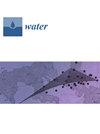Zinc Oxide/Moringa Oleifera Gum-Grafted L-Methionine-Functionalized Polyaniline Bionanocomposites for Water Purification
IF 3
3区 环境科学与生态学
Q2 ENVIRONMENTAL SCIENCES
引用次数: 0
Abstract
This study evaluates the preparation of novel ternary functional adsorbents based on polyaniline, zinc oxide nanoparticles, and moringa oleifera gum to produce zinc oxide/Moringa oleifera gum-grafted L-methionine-functionalized polyaniline bionanocomposites (ZM-g-Pani) and employed to sequestrate divalent metal ions (Cd2+, Hg2+ and Pb2+) from wastewater samples. The morphological and structural properties of ZM-g-Pani were exploited using FT-IR, FE-SEM/EDS, TEM, and XRD. FT-IR and FE-SEM studies show that the as prepared nanocomposite has an abundant number of reactive groups and a porous structure, thus demonstrating outstanding divalent metal cation removal. FT-IR study confirms that the attachment of L-methionine to polyaniline is facilitated by the C-S linkage. Both TEM and FE-SEM techniques confirmed the clustered granules of ZnO over the surface of polyaniline, which ultimately provided more surface area to adsorb metal ions. The study demonstrated that Cd2+, Hg2+ and Pb2+ ions could undergo physical sorption and chemisorption simultaneously during the adsorption process. The maximum adsorption capacity was 840.33, 497.51, and 497.51 mg/g for Cd2+, Hg2+, and Pb2+, respectively. The impact of co-existing ions, including NO3–, PO43–, SO42–, Cl–, Na+, Cu2+, and Al3+, showed that there were no notable alterations in the adsorption of the selected metal ions with ZM-g-Pani. ZM-g-Pani showed eight successive regeneration cycles for Cd2+, Hg2+, and Pb2+ with more than 85% removal efficiency.用于水净化的氧化锌/油橄榄树胶接枝 L-蛋氨酸功能化聚苯胺仿生复合材料
本研究评估了基于聚苯胺、纳米氧化锌颗粒和油杉树胶的新型三元功能吸附剂的制备情况,以制备氧化锌/油杉树胶接枝 L-蛋氨酸功能化聚苯胺仿生复合材料(ZM-g-Pani),并用于吸附废水样品中的二价金属离子(Cd2+、Hg2+ 和 Pb2+)。FT-IR 和 FE-SEM 研究表明,所制备的纳米复合材料具有大量的活性基团和多孔结构,因此对二价金属阳离子的去除效果显著。傅立叶变换红外光谱研究证实,L-蛋氨酸与聚苯胺的连接是通过 C-S 连接实现的。TEM 和 FE-SEM 技术都证实了聚苯胺表面的 ZnO 颗粒成簇,最终为吸附金属离子提供了更大的表面积。研究表明,在吸附过程中,Cd2+、Hg2+ 和 Pb2+ 离子可同时进行物理吸附和化学吸附。Cd2+、Hg2+ 和 Pb2+ 的最大吸附容量分别为 840.33、497.51 和 497.51 mg/g。共存离子(包括 NO3-、PO43-、SO42-、Cl-、Na+、Cu2+ 和 Al3+)的影响表明,ZM-g-Pani 对所选金属离子的吸附没有明显变化。ZM-g-Pani 对 Cd2+、Hg2+ 和 Pb2+ 连续进行了八次再生循环,去除率超过 85%。
本文章由计算机程序翻译,如有差异,请以英文原文为准。
求助全文
约1分钟内获得全文
求助全文
来源期刊

Water
WATER RESOURCES-
CiteScore
5.80
自引率
14.70%
发文量
3491
审稿时长
19.85 days
期刊介绍:
Water (ISSN 2073-4441) is an international and cross-disciplinary scholarly journal covering all aspects of water including water science and technology, and the hydrology, ecology and management of water resources. It publishes regular research papers, critical reviews and short communications, and there is no restriction on the length of the papers. Our aim is to encourage scientists to publish their experimental and theoretical research in as much detail as possible. Full experimental and/or methodical details must be provided for research articles. Computed data or files regarding the full details of the experimental procedure, if unable to be published in a normal way, can be deposited as supplementary material.
 求助内容:
求助内容: 应助结果提醒方式:
应助结果提醒方式:


